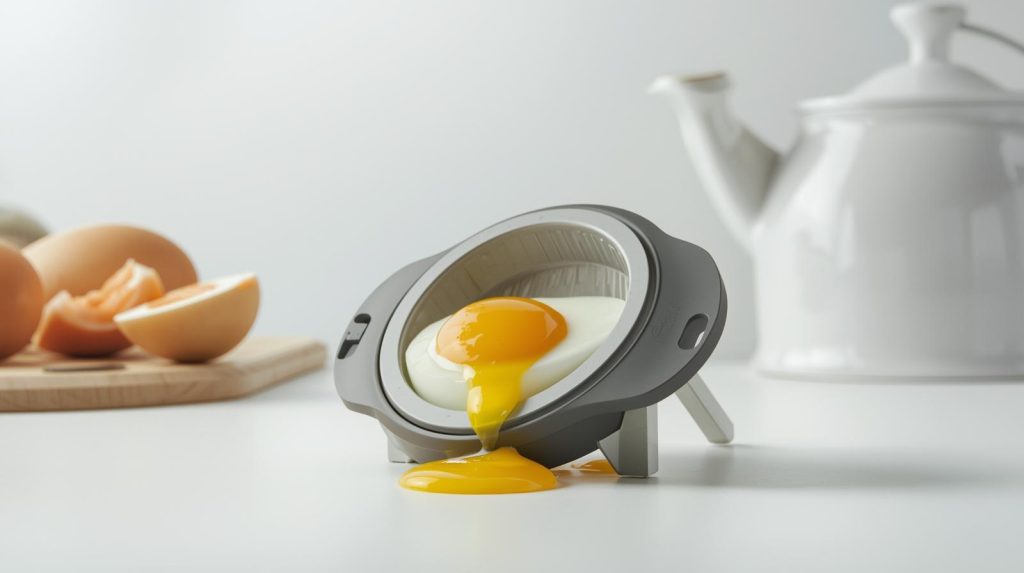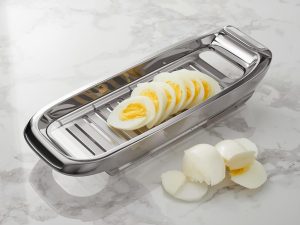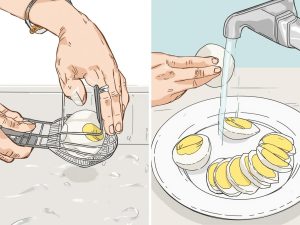I’ll be honest—I never thought I’d need an Egg Slicer. A knife always seemed fine… until my salad looked like it survived a tiny food fight. Broken yolks, uneven slices, and a bit of kitchen chaos convinced me otherwise..
Then I found a small tool that changed everything. Suddenly, my breakfasts looked professional, my sandwiches were perfectly uniform, and prep time dropped dramatically.

Here’s what you’ll discover in this guide:
- Why a simple kitchen cutter can improve your breakfast game
- The different types of egg cutters and how they work
- My favorite models for 2025, with pros and cons
- Tips to get perfect slices every time
- How to select the right one for your needs
- Answers to common questions about this handy tool
Why a Kitchen Egg Cutter Is Worth It
You might be thinking: “Do I really need this?” Trust me, yes. Even if you’re not a professional chef, a small slicer can save time, reduce mess, and make your meals look neat.
Here’s how I personally use mine:
- For salads: Uniform slices make a huge difference visually and make each bite balanced.
- For sandwiches: I hate uneven pieces messing up the bread.
- For garnishes: Deviled eggs or breakfast bowls are easier to decorate when slices are perfect.
Plus, pressing down and watching a flawless cut appear is oddly satisfying. Call it my quirky kitchen joy.
Types of Egg Cutters
Not all gadgets are the same. Knowing your options helps avoid regrets at the checkout:
1. Classic Wire Models
These are the standard devices, using thin wires to cut through a boiled egg. Simple, quick, and effective.
- Pros: Clean cuts, easy to use
- Cons: Wires can bend over time; may need replacement sooner than sturdier options
2. Plastic & Stainless Steel Versions
Plastic is lightweight and cheap, while stainless steel feels durable and lasts much longer.
- Pros: Steel is long-lasting, plastic is portable
- Cons: Plastic can crack, steel can be heavier to store
3. Multi-Functional Kitchen Helpers
Some gadgets go beyond slicing. They can wedge eggs or create criss-cross patterns for salads and desserts.
- Pros: Versatile and creative
- Cons: Larger footprint, slightly pricier
My Top Picks for 2025
Over the past year, I’ve tested multiple egg cutters in my kitchen, from budget-friendly wire models to high-end multifunctional gadgets. After some trial and error, a few have consistently stood out based on durability, ease of use, and overall value. Here’s a closer look at my favorites:
1. Classic Wire Cutter
The classic wire cutter is exactly what it sounds like: a straightforward, no-frills tool that gets the job done. I appreciate it for its simplicity. You place a boiled egg in the cradle, press down, and out comes a perfectly even slice every time.
- Why I like it: It’s quick, lightweight, and inexpensive. I often grab this when I’m in a rush or making multiple egg-based dishes.
- Best for: Everyday cooking, quick salads, and sandwiches where speed matters more than extra features.
- Practical tip: If you plan to slice a lot of eggs at once, keep a small bowl of water nearby. Dipping the wires occasionally prevents any sticking and keeps slices clean.
2. Professional Stainless Steel Cutter
For those who cook often or want a slicer that lasts years, a stainless steel model is a solid investment. Mine has been in the kitchen for months without any sign of wear. The frame feels sturdy, and the wires cut through eggs without bending or breaking.
- Why I like it: It’s durable, stable, and looks great on the counter. I also feel confident using it for delicate tasks like slicing slightly softer eggs without squishing them.
- Best for: Frequent cooks, those who prioritize quality, or anyone who wants a gadget that feels professional.
- Practical tip: Even though it’s dishwasher safe, I hand-wash the wires to prolong their life. Trust me, it makes a difference over time.
3. Multi-Functional Kitchen Tool
This is the slicer that doubles as a fun kitchen toy. In addition to standard slices, it can create wedges or criss-cross patterns. I love using it when I’m garnishing salads, making deviled eggs, or just experimenting with presentation.
- Why I like it: It adds creativity to everyday dishes. Plus, it’s surprisingly easy to use despite having more moving parts.
- Best for: Home cooks who enjoy plating, social media-worthy meals, or anyone looking to impress guests with neat, uniform cuts.
- Practical tip: Store this one separately from other utensils to prevent bending the wires. It’s versatile but slightly more delicate than the simpler models.
Each of these tools has its place in my kitchen. If you’re after speed and convenience, the classic wire cutter wins hands down. For long-term durability and professional feel, steel is the way to go. And for those who enjoy presentation and versatility, the multifunctional slicer is an absolute delight.
Internal link: You might also enjoy my guide on practical kitchen gadgets for other tools that simplify cooking and prep
Factors to Consider Before Buying
Even the best slicer can disappoint if it doesn’t match your cooking style. Here’s what I check before choosing one:
- Size & Capacity: Some gadgets handle one egg at a time; others can do two. Think about how many you cook regularly.
- Material: Plastic is budget-friendly and light, steel is sturdy and professional-looking.
- Ease of Cleaning: Dishwasher-safe versions save time, but I often hand-wash delicate wires.
- Safety: Non-slip bases or handles prevent accidents during slicing.
- Price vs. Value: Cheap cutters may break quickly, so it’s worth investing a little more.
Tips for Perfect Cuts Every Time
Even the best tool requires proper technique. Here’s how I ensure flawless slices:
- Cook Eggs Properly: Slightly overcooked yolks can crumble, undercooked ones squash. I aim for fully set but tender.
- Cool Eggs First: A quick rinse under cold water keeps slices clean.
- Press Gently: Let the cutter do the work—forcing it risks breakage.
- Clean Quickly: Egg residue dries fast; washing immediately prevents sticking.
- Experiment with Foods: I sometimes use mine for soft fruits or mushrooms for salads—it’s surprisingly versatile.
Other Creative Uses
Egg slicer aren’t just for eggs. Here are some surprising alternatives I’ve tried:
- Soft fruits: Strawberries, kiwis, and even ripe peaches slice nicely.
- Mushrooms: Perfect for salads or pasta toppings.
- Mini potatoes: For small boiled potatoes, a gentle press creates uniform pieces for roasting.
A small tool like this often proves its worth in unexpected ways.
Frequently Asked Questions (FAQ)
- Can I slice more than one egg at a time?
Most classic models handle one egg at a time, but some multi-functional tools allow two eggs simultaneously. I usually stick to one to avoid squashed slices. - Are all slicers dishwasher safe?
Many plastic and stainless steel gadgets are dishwasher-friendly, but delicate wires can bend over time. I hand-wash mine—it’s a tiny effort for a longer lifespan. - What’s the best material for durability?
Stainless steel is my top pick for long-term use. Plastic works fine for occasional cooking but tends to wear faster. - Can I slice other foods with my egg slicer?
Absolutely! Soft fruits like strawberries, kiwis, or ripe peaches work well. I’ve also used it for small mushrooms and even boiled mini potatoes for salads. Just avoid hard foods—they can bend the wires. - How do I avoid squished or uneven slices?
Cool your eggs first under cold water and let them set. Press down gently and let the tool do the work. Over-pressing can lead to messy slices. - Can I use my slicer for presentations or garnishing?
Definitely! Multi-functional slicers make wedges or criss-cross patterns. I often use them for deviled eggs or salads to impress guests with neat, uniform pieces. - How do I maintain my slicer wires?
Rinse after each use, and if possible, hand-wash to avoid wire damage. Occasionally, I dip the wires in warm water before slicing to prevent sticking. - Are slicers safe for kids to use?
I’d supervise young kids. While there are no sharp blades, wires can pinch fingers if handled incorrectly. Older kids or teens usually handle them just fine. - Can I slice very soft or slightly undercooked eggs?
Yes, but be careful. Soft eggs may squish if pressed too hard. I usually use slightly firmer eggs for neat slices. - How do I choose the right slicer for my kitchen?
Think about your priorities: speed, durability, or versatility. For quick, everyday slicing, I prefer a wire cutter. For frequent use, steel works best. And if you enjoy creative plating, a multifunctional tool adds flair. - Do slicers take up a lot of storage space?
Most are compact. Classic wire models are especially small, while multi-functional tools may need a bit more cabinet space. I keep mine in an easy-to-reach drawer. - Is it worth buying a more expensive egg slicer?
In my experience, yes. A durable slicer saves frustration in the long run. Steel versions last years, and multi-functional ones offer more creative options.
could bend or break wires.
Final Thoughts
Small gadgets often make the biggest difference in the kitchen. A Egg slicer might seem trivial, but it saves time, improves presentation, and adds a touch of fun to meal prep.
Personally, I wouldn’t go back to just using a knife. Slicing has become quicker, cleaner, and even slightly satisfying in a way I didn’t expect.
If you want your meals to look intentional, neat, and professional without extra effort, a reliable kitchen helper like this is worth every penny.
Internal link: For more small but essential kitchen tools, check out my kitchen gadget reviews